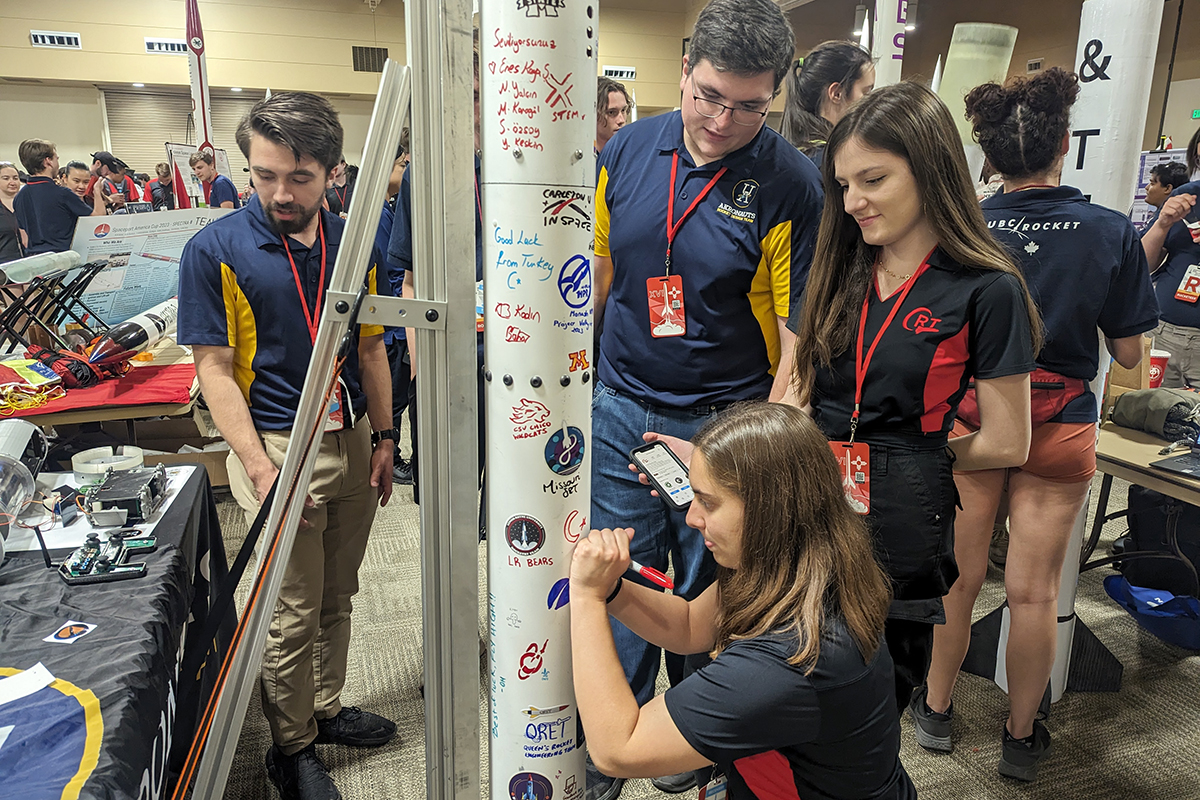Rocketing to success: Akronauts second-place triumph at Spaceport America Cup

The Akronauts, along with their mentor, Chris Pearson, at the Spaceport America Cup registration.
In the world of student rocketry, pushing the boundaries of innovation and achievement requires dedication and excellence. Such is the story of the Akronauts journey to the Spaceport America Cup in New Mexico this summer, where the student design team clinched the runner-up position in the 30k Student Researched and Designed (SRAD) category.
This year’s Spaceport America Cup competition brought together 159 teams from various institutions around the world. Among these, 120 teams earned their spot to compete on the much-anticipated launch day. Standing out among the elite were the nine teams, including the Akronauts, who competed in the SRAD 30k category—a testament to its difficulty compared to other competition categories. The SRAD 30k category, known for its challenging criteria, required teams to achieve an apogee as close as possible to 30,000 feet utilizing an SRAD propellant motor.
The team’s path to success began months before the competition as they kept up-to-date progress reports that tracked the advancements of their rocket, Imperium VI. They also provided the judges with an in-depth and accurate technical report that showed the intricacies of the rocket's excellent build and design quality, both of which were categories they highly scored in.

The pad crew putting Imperium VI up onto the launch rail.
The propulsion sub-team's achievement lay in reusing a proven motor iteration which demonstrated the motor's reliability and was a testament to their technical expertise. This launch marked the fifth time that the team’s SRAD “Angry Listerine” propellant was featured in a rocket.
The apogee score, while being an area for improvement, did not slow the team down as Imperium VI soared to an impressive altitude of 22,600 feet, only falling a mere 2,000 feet short of their predictions.
“Seeing Imperium VI fly during 18 mph winds and watching as we hit apogee, seeing drogue and main deploy and seeing it land gave the entire team a strong sense of accomplishment and pride,” said Daniel Montano-Lobe, Akronauts Structures Lead. “Imperium VI brought a lot of people together and created a stronger feeling of unity and camaraderie in the team.”
The team received full marks in the recovery category, for their development of a rocket that deployed its parachutes on time and at the correct altitudes, ensuring minimal damage upon landing. This was accomplished by utilizing CO2 ejection charges controlled by avionics bays containing altimeters, an SRAD data collection system, and a camera system.
A standout feature of this year’s design was the successful implementation of an onboard camera system. After several attempts in the past, this launch marked the first time the team’s two-angle camera setup flawlessly captured the entire flight.
Akronauts Spaceport 2023 flight footage of Imperium VI.
This past year, the payload sub-team focused on the concept of In Situ Resource Utilization (ISRU). By finding ways to reduce the amount of necessary resources brought on a journey to an extraterrestrial planet from Earth, weight and costs are reduced. The payload, named Extraterrestrial Natural Ice Collection System (ENICS), consisted of an Ice Collection Rover that located and mined extraterrestrial ice, and a HomeBase that processed the ice into purified drinking water for astronauts.
Throughout the project, payload members worked on a detailed SRAD 3D-model of the entire ENICS system, SRAD PCBs, Python and C programming, manufactured and machined custom parts, conducted stress tests, built a full-scale working ENICS payload, and gained experience on many other facets of engineering that will better equip the team going forward.
In a move that fostered camaraderie and connectedness, instead of a typical paint job, the Akronauts invited other participating teams to decorate and paint Imperium VI during the conference before launch day. This not only added a unique touch to its appearance but also created an opportunity to meet other teams and socialize.

Students from the Cornell Rocket Team signing Imperium VI.
The Akronauts continue to set their sights on the future as they reach new heights and push the boundaries of possibility with each rocket they launch. Students interested in joining the Akronauts can check out their website or contact them at uakronauts@gmail.com. Ad Astra!
RELATED CONTENT:
Story by CEPS Marketing.
Media contact: Cristine Boyd, 330-972-6476 or cboyd@uakron.edu.
